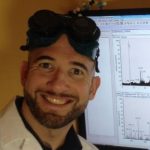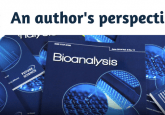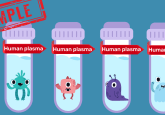Mass spectrometry could help prevent the next pandemic – but not if the technology is still an after-thought

 Ben Orsburn (Chief Scientist, Proteomic und Genomic Sciences, MD, USA) received his PhD at Virginia Tech (VA, USA) by applying mass spectrometry to solve biological problems. He has held positions at Johns Hopkins (MD, USA), Thermo Fisher Scientific (CA, USA), NIAID (MD, USA) and the National Cancer Institute (MD, USA). He has spent time developing LC–MS methods in over 150 labs around the world and utilizes these skills as the founder of LCMSmethods.org, a volunteer organization that provides validated instrument methods to researchers in an increasingly broad range of application areas.
Ben Orsburn (Chief Scientist, Proteomic und Genomic Sciences, MD, USA) received his PhD at Virginia Tech (VA, USA) by applying mass spectrometry to solve biological problems. He has held positions at Johns Hopkins (MD, USA), Thermo Fisher Scientific (CA, USA), NIAID (MD, USA) and the National Cancer Institute (MD, USA). He has spent time developing LC–MS methods in over 150 labs around the world and utilizes these skills as the founder of LCMSmethods.org, a volunteer organization that provides validated instrument methods to researchers in an increasingly broad range of application areas.
What can I say about the year that is 2020 – that hasn’t been more eloquently stated in advertisements for cheeseburgers and dishwashing detergent? We all know what this year has been like, and what the global pandemic we now call COVID-19 is continuing to do. However, going into the ninth month of this, I can’t help but continue to ask this question:
Did we, as a global community, choose the best technologies to put on the front line to combat this viral pathogen before it spiraled so far out of control?
I have my biases. The important fact is that I think proteins perform the work in cells. I think they do that by complex post-translational modifications and by altering the abundance of small molecules. I believe that nearly every disease works by disrupting proteins and metabolites. Also, I think that genetic technologies have lots of value, but they are indirect measurements and we spend more money on DNA/RNA because – well – the technology has been around much longer, so more people understand what is going on, even though the data is intrinsically less valuable. See? Biased.
These biases come from a career of directly measuring proteins and metabolites with mass spectrometry (MS). The technology I started with is so laughably crude compared to today’s equipment that you have to pay to get rid of the old stuff, or at least bribe some students to help you leave it behind a dumpster on campus. In the last 15 years or so we’ve achieved resolution, speed and sensitivity at levels beyond my wildest dreams when I started this journey. Despite all this power, we’ve mostly been forced to sit by helplessly and watch this virus tear across the world.
Don’t get me wrong, MS has contributed new information in the battle against this virus. Look at the amazing work of Christian Munch’s lab. The first study ‘Proteomics of SARS-CoV-2-infected host cells reveals therapy targets’ was the first MS study of infected cells to show up on a preprint server and an improved version rightfully found it’s way to the pages of Nature soon after [1]. The next study to appear in preprint had a similar theme and around 125 authors, the title ‘A SARS-CoV-2 protein interaction map reveals targets for drug repurposing’ was an amazingly large dataset of direct protein interactions of proteins from the virus and different drug treatments [2].
Why did these studies have such similar themes? It’s simple, it’s because when you are doing drug treatment studies, you use mass spectrometry. I’ve visited dozens of labs in big pharma around the world. Mass spectrometry is on the front lines in drug development in nearly all of them. Does genetics have a place? Absolutely. Huge cohort genetic studies can reveal trends in populations and is indispensable in these applications. If you want to do something fast with less data? You use mass spectrometry.
One of the biggest problems at the beginning of this pandemic – and even now, depending on where you are, has been determining who is infected with the virus. MS is used in clinical diagnostics all over the world. A Johns Hopkins Hospital study from Tan et al., in 2012 estimated that for every MALDI-TOF mass spec they installed, the hospital saved over $100,000 per year over traditional testing while maintaining the same throughput [3]. Multiple groups came to preprint showing MS diagnostic assays to determine SARS-CoV-2 infected individuals. Because….of course they did…. viruses hijack host mechanisms by making those host cells make viral proteins. There wasn’t a mass spectrometrist on the planet who didn’t think they could tell the difference between a person who had the virus and individuals that didn’t. This stuff is easy. The one that blew the doors off, though, was when the first group demonstrated they could do it FAST. A preprint by Cardozo et al., used LC–MS based diagnostics on an instrument capable of around 500 samples/day using a complex chromatography system. In a complementary approach Raymond Iles et al., recently preprinted results using instruments like the ones in used around the clock in the clinics at Hopkins. Dr Iles first presented this work about 6 months ago at the weekly London Proteomics Discussion Group (LPDG) meetings on COVID-19 research to show us MS nerds what none of us doubted was possible. MALDI-TOF could diagnose infected people rapidly with gear already in hospital clinics and they are, conservatively, capable of accurately diagnosing 500 tests/instrument per day. The benefit of this approach over the LC–MS based methods was the ease of sample prep for MALDI-TOF and the fact that many of these devices are already cleared for clinical diagnostics and most, if not all, hospitals already have them [4].
I would call these invaluable successes of MS technology in the battle against this virus. Why am I complaining, again? I’m complaining because these were the outliers. I’m complaining because every week we gathered at the LPDG, the questions on the slack discussion forums were always ‘how did you get samples?’ I’ll give you one extreme example of this.
Dr Sue Abbatiello is the Executive Director of The Barnett Institute in Boston (MA, USA) and one of the most well-known mass spectrometrists on the planet thanks to her work in proving LC–MS results can be reproducible between institutions. I’m not the only person who keeps her interlab studies for the Clinical Proteomic Tumor Analysis Consortium (CPTAC) on my desktop for easy reference [5]. I like to have it handy when someone says ‘LC–MS isn’t reproducible’ or ‘LC–MS isn’t ready for the clinic’. Surely someone identified on LinkedIn as the Director of a prestigious institute with a great resume of success in diagnostic mass spectrometry, with a desire to contribute to COVID research would have no problem finding ways to contribute. Right?
About 5 months ago Sue went to social media platforms like LinkedIn to try and get samples to test the development of diagnostic assays. She only just now got access to samples. In September. This isn’t the most extreme example. I know people who are still looking for samples and ways to help.
Is this just a way to whine about MS not getting the same opportunities as genomics to help out? I mean, really, what advantage does MS have over genetics techniques? Are my biases so pronounced that I’ve forgotten that MS also has disadvantages? Maybe? I hope not. I try to keep grounded because my job is to measure things. I know that my preferred technology has some limitations.
One big disadvantage of mass spectrometry is the up front cost. For context, a new qPCR set me back $18,000 USD this year. I’m aware I got a deal on it because the sales guy knows I’m not good enough to design my own primers and must buy pre-built diagnostic assays from him. He’s made his money back. Primers are cheap. Complete validated assays are not. Around that same time, I got a great deal on a high-resolution LC–MS system for $275,000 USD. However, that qPCR instrument needs primers and something that sounds like PacMan and some funny dyes and, ultimately, it works best when operated by an expensive expert that we ended up hiring. These costs rapidly add up and without these primers someone else designed, my little qPCR is useless. My mass spec, by contrast, has ran around 3500 samples since installation in June on the same HPLC column and has converted some solvent and a lot of really clean water to gas, because that’s what it needs to actually run. When I need to design a new assay for the instrument, I work out the exact mass of the thing I want to study, typically with a free App on my phone from MSBioWorks or on a free website called the Red Elephant and I start measuring.
You know about the failures of the qPCR based testing reagents this spring. Some primers were suboptimal and even without mistakes the designing, testing and manufacturing those kits and getting them out the door all take time, particularly on the scale that we needed them. To deploy these reagents requires a lot of infrastructure. The work I described from the Münch lab? They didn’t need any of these things. They needed the genome for the virus, which was preprinted in late January and they needed samples. Their facility is conveniently near a big airport and they had the correct biosafety level clearance that their government required for virus work and they were able to get samples from people arriving from infected areas. They had publicly available data supporting hypotheses of what drugs would be best for treating infected patients before a single person was tested for the virus in my home state.
Don’t get me wrong. That lab is good. I messaged an author right after the preprint came out. He was sleepy. They busted ass to get the work out that fast, but they were also fortunate. They got a chance to contribute and they grabbed that opportunity with both hands.
What could the rest of the MS field have accomplished if they had the same opportunity to contribute? If mass spectrometry hadn’t been an after-thought? I don’t know, but I hope that if something like this ever happens again groups like theirs have proven that we shouldn’t be an after-thought.
References
- Bojkova D, Klann K, Koch B et al. Proteomics of SARS-CoV-2-infected host cells reveals therapy targets. Nature 583, 469–472 (2020).
- Gordon DE, Jang GM, Bouhaddou M et al. A SARS-CoV-2 protein interaction map reveals targets for drug repurposing. Nature 583, 459–468 (2020).
- Tan KE, Ellis BC, Lee R, Stamper PD, Zhang SX, Carroll KC. Prospective evaluation of a matrix-assisted laser desorption ionization-time of flight mass spectrometry system in a hospital clinical microbiology laboratory for identification of bacteria and yeasts: A bench-by-bench study for assessing the impact on time to identification and cost-effectiveness. J. Clin. Microbiol. 50, 3301–3308 (2012).
- Iles RK, Zmuidinaite R, Iles JK, Carnell G, Sampson A, Heeney JL. A clinical MALDI-ToF Mass spectrometry assay for SARS-CoV-2: Rational design and multi-disciplinary team work. medRxiv doi:10.1101/2020.08.22.20176669 (2020).
- Abbatiello SE, Schilling B, Mani DR et al. Large-scale interlaboratory study to develop, analytically validate and apply highly multiplexed, quantitative peptide assays to measure cancer-relevant proteins in plasma. Mol. Cell. Proteomics 14, 2357–2374 (2015).
- Karina Helena Morais Cardozo, Adriana Lebkuchen, Guilherme Goncalves Okai et al. Fast and low-cost detection of SARS-CoV-2 peptides by tandem mass spectrometry in clinical samples, 16 September 2020, PREPRINT (Version 2) available at Research Square; [+https://doi.org/10.21203/rs.3.rs-28883/v2+]
The opinions expressed in this feature are those of the author and do not necessarily reflect the views of Bioanalysis Zone or Future Science Group.
Our expert opinion collection provides you with in-depth articles written by authors from across the field of bioanalysis. Our expert opinions are perfect for those wanting a comprehensive, written review of a topic or looking for perspective pieces from our regular contributors.
See an article that catches your eye? Read any of our articles below for free.




